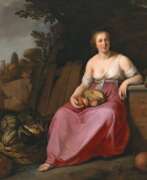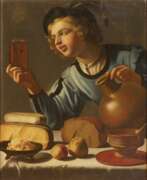The Netherlands Karavagism


Jacob Duck was a Dutch artist, celebrated for his etchings and paintings that vividly capture the essence of daily life, military scenes, and figures during the Dutch Golden Age. Born around 1600 in Utrecht, Jacob Duck initially trained as a goldsmith before turning his focus to painting, under the guidance of Joost Cornelisz Droochsloot. His journey took him from Utrecht to Haarlem and finally to The Hague, showcasing his adaptability and the breadth of his work across different Dutch cities.
Jacob Duck's artistry is distinguished by its intimate portrayal of soldiers and everyday scenes, marked by a keen observation of social interactions and the human condition. His works, housed in prestigious museums like the Hermitage Museum, underscore his significant contribution to art and culture, bridging the gap between the personal and the universal in the 17th century Dutch society.
One of his notable works, "A Couple in an Interior with a Fortune-Teller," housed at The Metropolitan Museum of Art, exemplifies Duck's unique approach to narrative in art. This painting diverges from the era's typical jovial depictions of fortune-tellers by presenting a scene charged with a palpable tension, reflecting Jacob Duck's ability to infuse his works with depth and complexity. The painting's intricate details and the backstory of its subjects further illuminate Duck's skill in blending storytelling with visual artistry, making him a pivotal figure in Dutch painting.
For collectors and art experts, Jacob Duck's oeuvre offers a fascinating glimpse into the Dutch Golden Age's socio-cultural landscape, characterized by a meticulous attention to detail and a profound understanding of human emotions. His legacy continues to captivate and inspire, underscoring the enduring relevance of his work in the realms of art and history.
To stay informed about new discoveries, sales, and auction events related to Jacob Duck's works, consider signing up for updates. This subscription service is designed exclusively for enthusiasts eager to deepen their appreciation of Duck's artistry, ensuring you're always in the know about opportunities to engage with his timeless creations.


Matthias Stom, also known by various names including Matteo Stoma, Matthias Stomma, and Matteo Fiammingo, is celebrated for his contributions to the Utrecht Caravaggist movement, though his exact ties to Utrecht itself are debated. Born around 1600, Stom's early life and training remain a matter of conjecture, with some speculation that he may have been trained in Utrecht within the late-Mannerist tradition. However, his work was deeply influenced by Caravaggio and his followers, especially through the dramatic use of chiaroscuro—a technique that plays with sharp contrasts between light and dark to create depth and volume in painting.
Stom spent a significant portion of his career in Italy, where his work resonated with the Caravaggist movement's emphasis on naturalism and tenebrism. The influence of Gerard van Honthorst, known for his candle-lit scenes, is evident in Stom's work, which frequently features similar dramatic lighting effects. His paintings, which number around 200 surviving works, often depict religious themes, showcasing his ability to imbue traditional stories with a profound psychological depth and a distinctive, clay-like treatment of flesh.
Stom's legacy includes a vast array of works that capture the essence of Caravaggist painting while maintaining a unique stylistic signature. His paintings are part of prestigious collections, including those of the Museo del Prado, which highlights his formative influences and the stylistic path he charted throughout his career.
For collectors and experts in art and antiques, Matthias Stom represents a fascinating study in the evolution of Caravaggist painting outside Italy, blending Northern European sensibilities with Italian dramatic intensity. His works offer a window into the baroque era's complex interplay of light, shadow, and human emotion.
To stay updated on new discoveries, sales, and auction events related to Matthias Stom, signing up for updates from art galleries and auction houses specializing in baroque art is advisable. This subscription ensures access to the latest information and opportunities to engage with the works of this distinguished artist within the rich tapestry of Caravaggist painting.


Dirk Jaspersz. van Baburen or Wijk bij Duurstede was a Dutch Golden Age painter, member of the Guild of Saint Luke of Utrecht. He is one of the leading representatives and creators of the Utrecht School of Caravaggio. Dirk van Baburen painted mainly on biblical and mythological subjects, as well as genre scenes with drunks and musicians.


Jan Hermansz. van Bijlert, or Jan van Bijlert, or Giovanni Bilardo, is a Dutch painter of the Dutch Golden Age, considered one of the Caravaggio school in Utrecht. He spent about four years in Italy and was one of the founders of the Bentvueghels circle of northern artists in Rome, where he was nicknamed Aeneas. Van Beilert was one of the most famous artists of the city of Utrecht. He mainly painted religious and mythological scenes, genre scenes of public places and musical parties, but he was also a portraitist.


Gerard van Honthorst (Dutch: Gerrit van Honthorst) was a Dutch Golden Age painter who became known for his depiction of artificially lit scenes, eventually receiving the nickname Gherardo delle Notti ("Gerard of the Nights"). Early in his career he visited Rome, where he had great success painting in a style influenced by Caravaggio. Following his return to the Netherlands he became a leading portrait painter.


Peter Wtewael was a distinguished Dutch Golden Age painter, known for his exquisite kitchen scenes and mythological figures. Born on June 5, 1596, in Utrecht, he was part of a notable family of artists, with his father Joachim Wtewael and brother Johan Wtewael also being recognized painters. Peter's work is characterized by its vibrant depiction of daily life and classical themes, reflecting the influence of Caravaggio in his use of dramatic lighting and realistic details.
One of Peter Wtewael's notable works, a "Kitchen Scene," is celebrated for its detailed and lively representation of a genre scene, showcasing his mastery in capturing the essence of everyday life during the Dutch Golden Age. This work, along with others, highlights his ability to intertwine erotic themes with humor and naturalistic representation, drawing parallels between the indulgence in food and carnal desires.
Peter Wtewael's contribution to art extends beyond just his paintings; his works are part of the collections of prestigious institutions like The Metropolitan Museum of Art, indicating the lasting impact of his artistic vision. His expertise in portraying both the simplicity of kitchen life and the complexity of mythological narratives has cemented his place in the history of Dutch art.
For collectors and experts in art and antiques, Peter Wtewael's paintings offer a fascinating glimpse into the Dutch Golden Age's rich tapestry of culture, history, and artistry. His legacy is preserved through his vibrant and detailed scenes, which continue to captivate and inspire audiences.
To stay informed about exhibitions, sales, and auctions related to Peter Wtewael, consider signing up for updates from art galleries and auction houses. This will ensure you have the latest information on opportunities to appreciate and perhaps acquire works by this master of the Dutch Golden Age.





